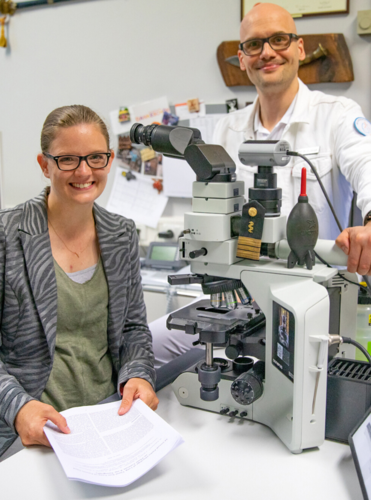A large number of pulmonary diseases are accompanied by a so-called pulmonary hypertension. This results in increased pressure in the pulmonary circulation carrying deoxygenated blood to the lung and oxygenated blood back to the heart. Those affected suffer from respiratory distress, chest pain and weakness. In the long term, pulmonary hypertension can lead to complete overload of the right ventricle and even to death. For the treatment and prognosis of the disease, it is important to know whether the problem lies in the arteries or the veins of the pulmonary vessels. However, it is difficult to distinguish between pulmonary arterial hypertension (PAH) and the very rare pulmonary veno-occlusive disease (PVOD). A research team at the German Center for Lung Research (DZL) at the BREATH site has now found a new approach to more accurately define the diagnosis using molecular markers. The study will be published in the American Journal of Pathology and is available online.
An accurate diagnosis is of vital importance
„The development and progression of PVOD have been inadequately understood until now“, says the Principal Investigator, Dr. Lavinia Neubert, a member of the Lung Research Study Group at the Institute of Pathology, Hannover Medical School (MHH). In addition to this, is the fact that PAH and PVOD are clinically very similar, making an exact diagnosis difficult. But this is important, since the treatment and prognosis depend heavily on whether the vascular alteration occurs in the arterial or venous pulmonary circulation, and as a result the blood vessels in the lungs constrict, become blocked or are completely destroyed. „A conventional therapy for PAH to lower the pulmonary hypertension using vasodilatory agents can, in the case of PVOD, lead to a worsening of the symptoms and even life-threatening pulmonary edema“, the pathologist stressed. Regardless of this, pulmonary hypertension is incurable and can only be kept under control with medication. As a last resort, only a lung transplant remains up to now.
Six target genes qualify as molecular markers for the differentiation
In the study, lung samples from female and male patients with PAH, PVOD, idiopathic pulmonary fibrosis (IPF) and chronic obstructive pulmonary disease (COPD) were analysed and compared with healthy lung tissue. The researchers discovered six target genes, which qualified as molecular markers for the differentiation between PAH and PVOD. „An accurate diagnosis of PVOD has only been possible up to now using tissue analysis, although a biopsy always poses a great risk for patients with pulmonary hypertension due to the danger of bleeding“, explained Professor Dr. Danny Jonigk, Head of the Lung Research Working Group. The next step will now be to investigate whether the molecular markers can also be detected in the patients‘ blood and urine. If that is the case, this could greatly facilitate the early diagnosis of PVOD and the distinction between PVOD and PAH.
The original publication „Molecular Profiling of Vascular Remodeling in Chronic Pulmonary Disease“ is available here.
Text: MHH
Photo: Karin Kaiser/ MHH

Dr. Lavinia Neubert and Prof. Dr. Danny Jonigk